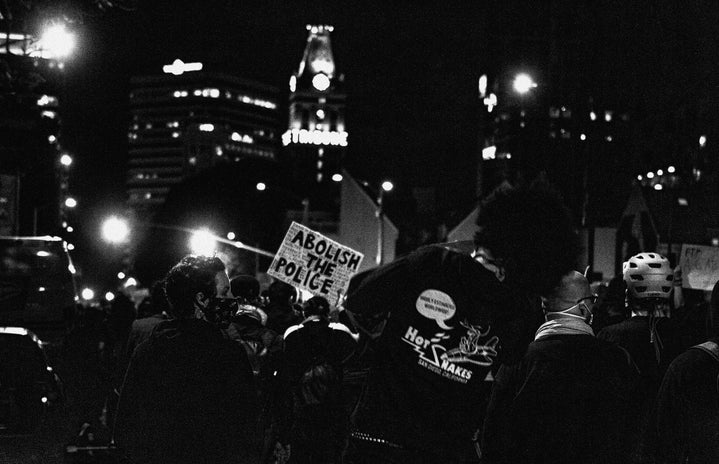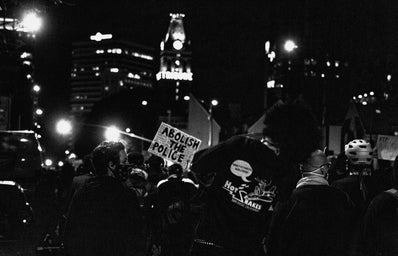The 13th Amendment: “Neither slavery nor involuntary servitude, except as a punishment for crime whereof the party shall have been duly convicted, shall exist within the United States, or any place subject to their jurisdiction.” The 13th Amendment deems slavery as illegal, yet, it has an exemption. Slavery is legal when that person, the slave, is deemed a criminal. This clause is a loophole. A loophole that has been used since the day of its enactment.
Let’s take a look at the American prison system: the United States is home to 4.25% of the world’s population, yet 25% of the world’s prisoners. America is considered a small country – a small country that only holds 4.25% of the entire world’s population, and somehow holds a quarter of all prisoners in the world. That means that one out of every four humans in America are in prison or have been in prison. One out of four people are shackled and locked up – here – in “the land of the free”. The prison population in 1972 was 300,000. In 2016 the prison population was 2.3 million. The United States has the highest rate of incarceration in the world. There are various reasons for this shocking statistic – one being because of the U.S.’ privatized economic system. Which allows for things that should be public (i.e. hospitals, schools, prisons) to become privately owned and controlled. This cuts off government oversight of these institutions, and therefore allows for these institutions to control the flow of revenue and persons that enter these institutions at will – it basically allows for the commodification and capitalization of mass incarceration. Whilst this heavily aids in the disparage of statistics when comparing to other countries, it is not the main cause.
When looking at the history and complexity of slavery, one also has to understand the economic system during the demise of slavery at the end of the Civil War. The Southern economy was entirely based on slave labor – by deeming slavery illegal, it destroyed the Southern economy. This caused there to be a lingering question for those who were formerly considered property and were formerly an “integral part of the economic production system in the South”: How do you rebuild your economy? The 13th Amendment loophole was instantly turned to and exploited after the Civil War. African-Americans were mass arrested with the creation of new laws, such as the vagrancy laws; which were an essential part of the Black Codes. The Vagrancy Act was passed in 1824, deeming it a crime for a person who was homeless and/or jobless to wander within public areas without the visible means to support those places. In layman’s terms it means that people who did not have a home or a job after the Civil War (previously enslaved people) were breaking the law by not working and supporting their economy. These arrests were made based on whether you were deemed as able bodied for work and were not actively working. This Act gave police unlimited power and denied the right of due process for those who were arrested.
Now that you’ve been arrested for committing vagrancy, you have a charge on your record. You’re now a criminal; and as it is known, criminals can be given a sentence of slavery. At this point in time police were arresting African-Americans for extremely minor offenses such as vagrancy or loitering, putting them into prison, and then having a court order for their term to be served out through slavery.
What happened after this was a portrayal and mythology of black criminality. Within these bills that were being passed, they would articulate the writing carefully, aiming it towards the criminalization of African-Americans. The media had a large impact on this demonization as well. Films such as The Birth of a Nation painted white supremist groups as the heroes and African-Americans as these inherently evil individuals with no rationality. “Birth of a nation confirmed the story that many whites wanted to tell about the civil war and its aftermath. To erase defeat and to take out of it sort of a martyrdom. Woodrow Wilson, the sitting president, had a private screening of Birth of a Nation in the White House. He called it history written with lightning.” Every image of an African-American within the film and within the media at the time deemed them as being animalistic – sometimes even cannibalistic. All of these myths of African-American men being rapists and a threat to white women stemmed from the reality that the white political elite and business establishment needed free labor.
Flash forward to 1954; after the rebirth of the KKK and the horrendously violent crimes committed by them during the end of reconstruction; the beginning of The Civil Rights movement occurs. The visceral image of criminality is still tied to African-Americans, however, the Civil Rights movement was able to turn the image of being arrested around. It became a noble thing to be arrested during the movement and during the protests. That was one of the first times in history that African-Americans weren’t solely viewed with this white-lens of criminality. “We were willing to be beaten for democracy, and you misuse democracy in the street.” The Voting Rights Act and the Civil Rights Act were put into effect, as an attempt to fix the history-long withholding of basic human rights from African-Americans and other minorities. However, during this time there was a rise in crime rates; it was the perfect opportunity for politicians to point to the Civil Rights movement as the cause of this.
The prison population was mainly stagnant during this time, all the way throughout the late 1960s. However, that all changed in the 1970s. The 1970s was a point in time that was defined as mass incarceration. The “law and order” trend amongst politicians began during the Nixon era. Nixon coined the term “war on crime” – creating this idea that crime was rampant, so much so that we needed to fight a war to end it. However, this term was a political code word. It’s what experts call “dog-whistle politics”. What politicians during this time were really referring to were the black political movements; the Black Panthers, Black Power, the antiwar movement, the movement for women and gay’s liberation – all of which Nixon felt compelled to fight back against. There was an outcry from the white population for ‘law and order’. Nixon responded to this outcry, saying that he would wage what was called “total war” against public enemy number one of the United States: “the problem of dangerous drugs.” A war on drugs. That phrase that would echo throughout the years to come, caused there to be this decision of dealing with drug addiction and drug dependency as a crime issue rather than a health issue. Thousands of people were sent to jail for the simple possession of marjiuana, for low-level offenses.
This call for law and order is a political tactic that is now known as the “Southern Strategy.” This was a backlash to the Civil Rights movement. By using racially veiled terms that appealed to the white population, Nixon was able to recruit more people into the republican party through the curtain-campaign of the law and order period. Nixon’s domestic policy chief at the time, John Ehrlichman, later admitted that the war on drugs was designed to demonize and criminalize African-Americans. “The Nixon campaign in 1968, and the Nixon White House after that, had two enemies: the antiwar left and Black people. You understand what I’m saying? We knew we couldn’t make it illegal to be either against the war or Black, but by getting the public to associate the hippies with marijuana and Blacks with heroin, and then criminalizing both heavily, we could disrupt those communities. We could arrest their leaders, raid their homes, break up their meetings, and vilify them night after night on the evening news. Did we know we were lying about the drugs? Of course we did.” The war on drugs continued through the Regan era, which greatly contributed to its continuance with Nancy Reagan’s campaign “Just Say No”.
In the 1980s there was the debut of a new drug called crack cocaine. What the Regan era does is take the problem of economic inequality, of hypersegregation, and the issue of drug abuse and criminalizes all of it in the form of the ‘war on drugs’. The era of the war on drugs was essentially a war on communities of color. It turned into something that was almost genocidal. By playing on the fear of crime, these two political eras and campaigns were able to bring back that image of the animalistic black criminal – of dehumanization. The media, as always, played an integral role in this portrayal. There was constant streaming of the raids on communities of color homes, of young African-American men being handcuffed and shoved into police cars, of Latinx communities being torn apart. There was an overrepresentation and mass flooding of these depictions – even though they were rarely accurate. With these depictions came a new term, the “super predator”. Super predators were people who were “crazy” and were deemed to have the intent of harming white women and children. This term was used in the case of the Central Park Five. A case in which five boys – children – were convicted of the rape and assault of a female jogger in Central Park. The boys were convicted as children, some given adult sentencing, and lost between 6-12 years of their lives in prison. During this time, Donald Trump called for the death penalty for the boys, saying that they were super predators.
There is a clear pattern throughout history. A labeling of criminal and criminality on people of color – specifically African-Americans. It has carried on to the current day. There is much, much more history to this story, to the abuse and criminalization of the African-American community, that I urge you to delve into. To the assassinations of black Civil Rights leaders, to the disgusting acts committed by the KKK against the African-American community, to the economic inequality of people of color – to the history that we should know, that we should have been taught. Yes, it is going to make you uncomfortable, history is not supposed to be a child’s storybook. But it is necessary and vital that we begin educating ourselves; something we should have done ages ago. In order to be allies and aid those that endure this intersectional oppression. In order to change future history, you first have to understand the past.


